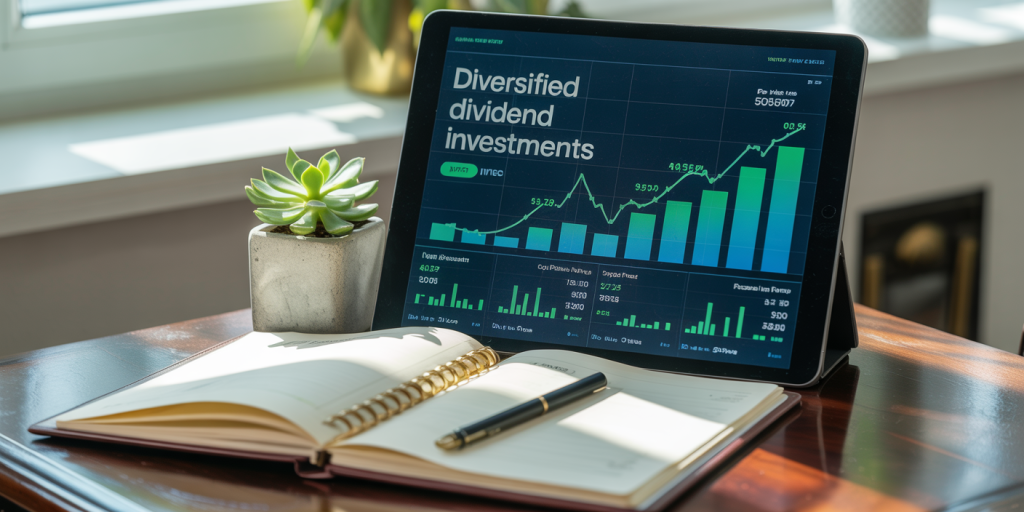Dividend Investing: How to Build Passive Income Streams
In the landscape of personal finance and wealth management, dividend investing has emerged as one of the most effective strategies for building sustainable passive income streams. Unlike capital gains-dependent investments that require frequent buying and selling, dividend investing offers a more predictable and steady flow of income over time. This method involves purchasing shares in companies that distribute a portion of their profits to shareholders, usually on a quarterly basis. Understanding how to harness dividend investing strategies can significantly enhance financial security and growth over the long term.

Dividend income is particularly appealing as it offers a level of stability even during market downturns. Many long-term investors, including retirees and those seeking to supplement their salaries, rely heavily on dividends to maintain cash flow without tapping into their principal investment. According to a 2023 report by Hartford Funds, nearly 60% of total stock market returns over the past 50 years have come from reinvested dividends, emphasizing their vital role in portfolio growth.
Understanding Dividend Investing: Key Concepts and Benefits
At its core, dividend investing involves selecting stocks that consistently pay dividends to shareholders. These payments can vary widely, from stable blue-chip companies offering modest dividend yields to high-yield stocks which may carry higher risk but potentially greater payouts. Investors generally look at two metrics to assess dividend stocks: dividend yield and dividend payout ratio.
Dividend yield is the annual dividend payment divided by the stock’s current price, expressed as a percentage. For example, if a company pays an annual dividend of $2 and its stock price is $50, its dividend yield is 4%. The dividend payout ratio, on the other hand, shows the proportion of earnings paid out as dividends. A sustainable payout ratio usually falls between 30% and 60%, demonstrating the company’s ability to maintain dividends without jeopardizing growth.
Anúncios
The primary benefits of dividend investing include regular income, compounding through reinvestments, and potential protection against inflation. Dividend payments provide a buffer against market volatility, often outperforming non-dividend stocks in bear markets. For instance, during the 2008 financial crisis, dividend-paying stocks saw an average decline of around 30%, compared to a 40% drop in non-dividend stocks, per data from S&P Dow Jones Indices.
Building a Dividend Portfolio: Strategies and Practical Examples
To create an effective dividend portfolio, investors must apply a disciplined approach to selecting and balancing their holdings. Diversification across sectors and geographies reduces risk and exposure to cyclicality in any one industry. Investing in Dividend Aristocrats—companies that have increased their dividend payouts for at least 25 consecutive years—is a common strategy among dividend investors seeking reliability.
For example, consider an investor choosing between Procter & Gamble (PG) and ExxonMobil (XOM). P&G, a Dividend Aristocrat with over 60 years of consecutive increases, offers stability and steady dividend growth, with a current yield of approximately 2.5%. ExxonMobil, in contrast, provides a higher yield near 4%, but with more sensitivity to commodity price fluctuations. A balanced portfolio might include both to capture diverse income streams.
Utilizing dividend reinvestment plans (DRIPs) can exponentially increase returns by purchasing additional shares automatically with dividends earned. For instance, if an investor holds 100 shares of Coca-Cola (KO) paying an annual dividend of $1.92 per share, reinvesting these dividends allows acquiring more shares over time without further capital injections. Historical data show that reinvested dividends contributed significantly to Coca-Cola’s total return of nearly 500% over the past 20 years, as per Morningstar.
Anúncios

Comparative Table: Characteristics of Dividend Portfolio Approaches
| Strategy | Yield Range | Risk Level | Ideal Investor Profile | Example Stocks |
|---|---|---|---|---|
| Dividend Aristocrats | 2%-4% | Low | Conservative, long-term growth | Johnson & Johnson, P&G |
| High-Yield Dividend Picks | 4%-7%+ | Moderate-High | Income-focused, tolerates risk | AT&T, Altria Group |
| Dividend Growth Stocks | 1.5%-3.5% | Moderate | Growth + income, long horizon | Microsoft, Visa |
| REITs and MLPs | 5%-8%+ | Moderate-High | Income seekers, diversification | Realty Income, Enterprise |
Risks and Challenges in Dividend Investing
While dividend investing offers many advantages, it also comes with inherent risks and potential pitfalls. The biggest risk is dividend cuts or suspensions, which can negatively affect both income and share price. Companies may reduce dividends due to earnings shortfalls, cash flow issues, or economic recessions. For example, during the COVID-19 pandemic, over 140 dividend cuts were reported in S&P 500 companies in 2020 alone, highlighting the vulnerability of dividend streams to economic shocks.
Another challenge is the risk of chasing high dividend yields without adequate fundamental analysis. Extremely high yields may be a “dividend trap,” signaling underlying financial distress or unsustainability. Investors should critically assess a company’s payout ratio, cash flow stability, and earnings consistency before investing. Additionally, overconcentration in high-yield sectors such as utilities or telecoms can limit diversification.
Tax considerations also play a role depending on the investor’s jurisdiction. In many countries, dividend income is taxed at a different rate than capital gains, sometimes at a higher bracket, which can impact net returns. Utilizing tax-advantaged accounts like IRAs or Roth IRAs in the U.S. can mitigate this disadvantage.
Incorporating Dividend ETFs and Mutual Funds
For investors seeking diversification without direct stock selection, dividend-focused Exchange-Traded Funds (ETFs) and mutual funds offer a convenient alternative. These funds pool capital to invest in broad baskets of dividend-paying stocks, spreading risk and reducing single-company exposure.
For instance, the Vanguard Dividend Appreciation ETF (VIG) tracks companies with a record of increasing dividends for at least 10 consecutive years. Its broad exposure and low expense ratio make it attractive to cost-conscious investors. Similarly, the Schwab U.S. Dividend Equity ETF (SCHD) weighted towards high-quality dividend payers, has an average yield near 3.1% as of 2023.
Mutual funds like the T. Rowe Price Dividend Growth Fund (PRDGX) provide active management with a focus on dividend growth stocks, aiming for a blend of income and capital appreciation. A key advantage of funds is professional management, which can navigate complex market environments and perform rigorous analysis on dividend sustainability.
Example: Comparing Dividend ETFs
| ETF Name | Dividend Yield | Expense Ratio | Dividend Growth Focus | Top Holdings |
|---|---|---|---|---|
| Vanguard Dividend Appreciation (VIG) | 1.8% | 0.06% | Yes | Microsoft, Johnson & Johnson |
| Schwab U.S. Dividend Equity (SCHD) | 3.1% | 0.06% | Moderate | Home Depot, Pfizer |
| iShares Select Dividend ETF (DVY) | 3.5% | 0.39% | Moderate-High | ExxonMobil, AT&T |
Steps to Optimize Dividend Income and Reinvestments
Optimizing dividend income requires strategic steps beyond merely purchasing dividend stocks. First, investors need to establish clear financial goals, understanding how much passive income is needed and by when. This clarity helps in choosing yield targets and acceptable risk levels.
Second, employing a disciplined reinvestment plan accelerates portfolio growth via compounding. Investors should ideally reinvest dividends, especially in tax-advantaged accounts, to maximize the long-term benefits. Dollar-cost averaging into dividend stocks during market dips can also enhance yield-on-cost over time.
Third, regular portfolio reviews are essential to ensure dividend sustainability and manage sector risks. This includes tracking payout ratios, earnings outlooks, and macroeconomic conditions that influence dividend policies. For example, utility companies often cut dividends when interest rates rise due to increased borrowing costs.
Lastly, diversifying across asset classes—such as integrating Real Estate Investment Trusts (REITs), Master Limited Partnerships (MLPs), and international dividend stocks—can provide better overall yield and reduce home-country risk.
Future Perspectives: The Evolution of Dividend Investing
The future of dividend investing looks promising in a low-interest-rate world where fixed income returns remain muted. With investors hungry for reliable income, dividend stocks are expected to retain their appeal. However, emerging trends such as environmental, social, and governance (ESG) considerations are reshaping dividend strategies. Companies with strong ESG profiles are increasingly favored by dividend investors as they combine financial sustainability with social responsibility.
Technological advancements also enable better dividend screening and portfolio management tools, enhancing decision-making. Platforms powered by artificial intelligence can analyze vast datasets to predict dividend sustainability with improved accuracy.
Moreover, globalization continues to open new frontiers for dividend investors. Countries like Canada, Australia, and parts of Europe offer attractive dividend yields and diversification opportunities. However, investors will need to carefully consider currency risks and tax treaties when venturing internationally.

Statistical Outlook
According to a 2024 report by CFRA Research, dividend growth forecast in the S&P 500 for 2024 is projected to increase by approximately 7%, reflecting corporate earnings strength and economic recovery momentum. This trend suggests that dividend income streams are likely to become an even more essential component of total investment returns going forward.
In conclusion, dividend investing remains an effective way to build passive income through consistent payouts, reinvestments, and strategic portfolio construction. As markets evolve, investors who embrace dividend discipline, innovate with new tools, and diversify geographically will be well-positioned to enjoy reliable income growth for years to come.
